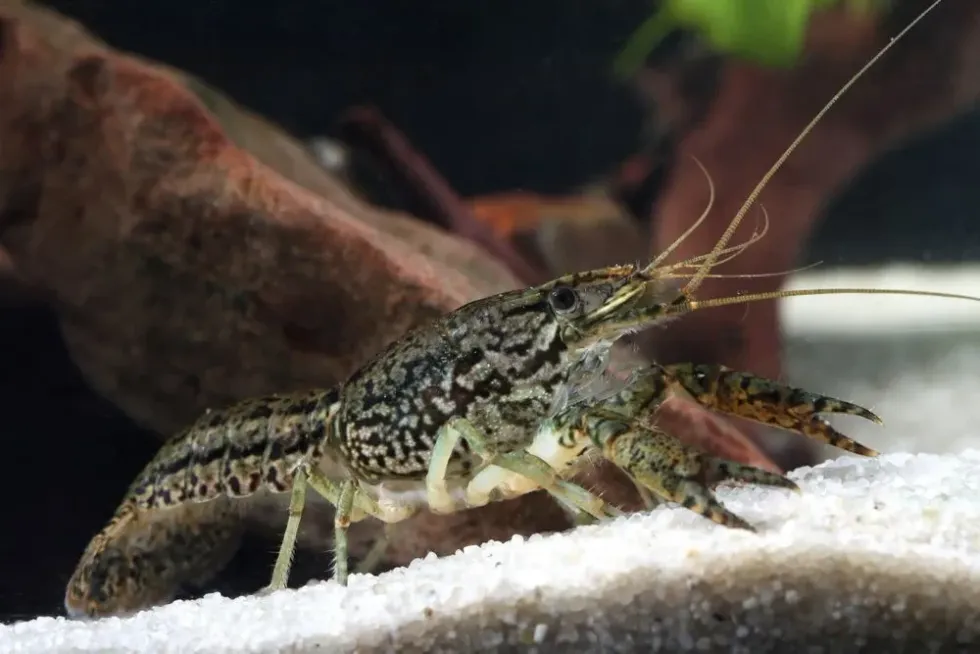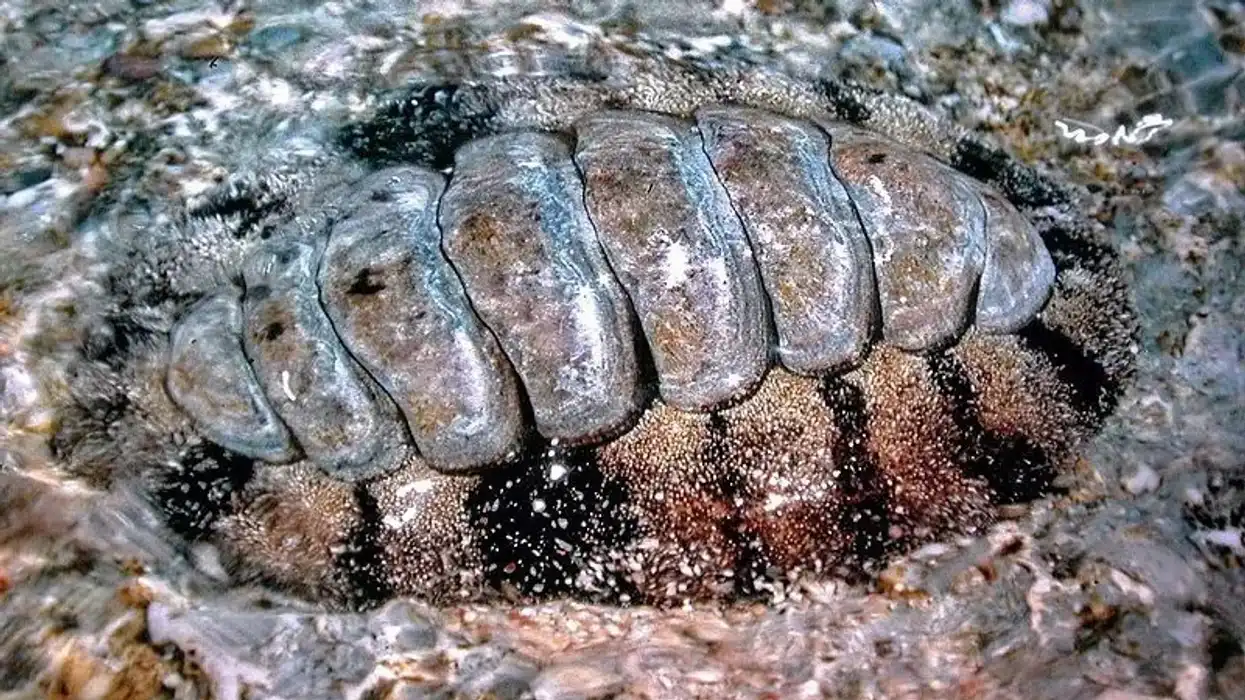Have you heard about the marmorkrebs? Marbled crayfish (Procambarus virginalis) or the marmorkrebs are a self-cloning invasive species.
This crayfish species is a kind of freshwater crayfish. They are mainly kept as pets, but many have recently been found in the wild. They are seen in the wild in Germany, Madagascar, the United States, and many other parts of the world.
Their uniqueness is that they reproduce by the self-cloning process. The offspring are genetically identical to their mothers.
As these clones of the marbled crayfish are identical to their mothers, there only exist females. Their growth depends a lot on their surrounding environment. They feed on small fish, snails, algae, detritus, vegetables, and worms.
These crayfish can live in any kind of water, even in dirty water, but if you are keeping them as pets in the tanks, then it's advisable that you keep the tank water clean. Caring for the species is not that hard.
Read on if you want to learn more about the German marbled crayfish or blue marbled crayfish. If you like this article, then check out the blobfish and slipper lobster.
Marbled Crayfish Interesting Facts
What type of animal are marbled crayfish?
The marbled crayfish (Procambarus virginalis) is a kind of decapod crustacean. It is known to be a self-cloning invasive species.
What class of animal do marbled crayfish belong to?
Marbled crayfish belong to the class Malacostraca of animals.
How many marbled crayfish are there in the world?
The marbled crayfish was first found in the mid-1990s through the German pet trade. Since then it has spread across many places through the pet trade and many were also found living in the wild later on.
As the species is an invasive species, their population has grown manifolds. Even one of the animals can multiply into a population of one place. Hence, getting the exact number of the population of the species is extremely difficult and thus not known.
Where do marbled crayfish live?
Marbled crayfish or marmorkrebs are mainly known to live as pets in many parts of the world, and they were first found through the German pet trade. Other than that, many among the species have been found living in the wild throughout Germany.
In the United States, they have been seen around Florida and southern Georgia. In the Netherlands, around 30 marbled crayfish were introduced and they have been known to be living there still.
Singles of the species were respectively seen to be living in Italy and Japan. In Madagascar, it was introduced in 2003, and since then, the species has taken over eight of the 22 regions of the country.
What is a marbled crayfish's habitat?
Marbled crayfish have not been known to be native to one habitat as such. The population that was introduced to many areas has been seen living in both still and moving freshwater habitats. They are found living in lakes, brick or clay pits, rivers, swamps, fish ponds, and rice paddies.
Who do marbled crayfish live with?
Decapod crustaceans like the marbled crayfish are known to live solitarily or in a sub-social structure. These self-cloning crayfish have the ability to multiply in many numbers from just one single organism, but otherwise, they are known to live a solitary life.
How long do marbled crayfish live?
The marbled crayfish live for about two to three years.
How do they reproduce?
The population of the marbled crayfish or marmorkrebs only consists of female crayfish. No male has been known to exist to date.
The crayfish reproduce asexually. Marbled crayfish breeding occurs by the self-cloning process.
The process is called apomictic parthenogenesis. In this process, the offspring are born as clones of their mother and thus, they are all born females. This means that they don't need to mate and even a single female marbled crayfish can give birth to many of the species.
The breeding season of the species varies according to the geographical location of the species. These crayfish are known to become sexually mature at a very young age, and it has been observed by research that their breeding process is highly dependent on the temperature around them.
They have been seen to be most fertile at 86 F (30 C). They lay around 700 eggs at a time and then the mother broods for about the next 22-42 days.
What is their conservation status?
The species of marbled crayfish is Not Listed under the International Union for Conservation of Nature Red List. The species hasn't been discovered long back, and they are known as invasive species.
They also mature at a young age, so their population is rising everywhere in a short amount of time and at a high rate. We can surely assume that they are not endangered in any way at this time.
Marbled Crayfish Fun Facts
What do marbled crayfish look like?
The appearance of the marbled crayfish varies quite a lot. These are medium-sized crayfish, and as the name suggests, their carapace includes a marble pattern.
They have claws that are relatively smaller than their carapace and are narrow. Most marbled crayfish that live in the wild are dark brown to olive in color. The color of the ones that are seen in an aquarium can also be tan to reddish, or blue.
How cute are they?
They can be considered cute by many people. They have a beautiful marbled pattern on their back, and they have their own unique quality where they are known for the ability of self-cloning.
Marbled crayfish, however, can be mischievous and somewhat destructive as a pet. Hence, however charmed you are by them, if you are keeping them as a pet, keep an eye on them.
How do they communicate?
Not much is known about the way marbled crayfish communicate. Crayfish generally communicate through biochemical means. They secrete a kind of chemical and others of their species comprehend the signal through that. They mainly secrete the chemical by their urine.
How big are marbled crayfish?
The marbled crayfish size is about 4-5 in (10.2-12.7 cm) in length. The marbled crayfish are about six times smaller than the Tasmanian giant freshwater crayfish. These crayfish are the largest among the many crayfish species and they are about 31 in (78.7 cm) in length. Another fish that is this size is the angelfish.
How fast can marbled crayfish move?
Other than the two claws of the marbled crayfish, they also have eight legs by which they move. The exact speed at which they move is not known, but they have been seen moving at a moderate speed.
How much do marbled crayfish weigh?
Marbled crayfish are medium-sized crayfish. Research has shown that these crayfish weigh more or less 1.6 oz (45 g). They have about the same weight as one of the most common crayfish, the red swamp crayfish. The red swamp crayfish weighs around 1.8 oz (50 g).
What are the male and female names of the species?
There is no record of the existence of male marbled crayfish. Their entire population consists of females. The females don't have any other given names. They are called female marbled crayfish.
What would you call a baby marbled crayfish?
A baby marbled crayfish is called a hatchling.
What do they eat?
Marbled crayfish are omnivorous in nature. They eat both animal-based and plant-based food. The ones living in the wild have mainly been seen eating algae, detritus, invertebrates, and plants.
If you have one as a pet in your aquarium, and you have water plants inside, chances are they will feed on it. If your aquarium has floating plants, then they might survive.
You can give them vegetables like zucchini, cucumber, cabbage, or spinach. You will notice that they can survive on plant-based food pretty well, but you will still need to give them animal-based food as well. You can feed them brine shrimp, earthworms, snails, and blackworms.
Are they edible?
There have been no records of the marbled crayfish being poisonous, and as many other crayfish are eaten by humans, we can assume that eating marbled crayfish is possible as well. People keep these crayfish as pets.
Marbled crayfish, edible or not, are not bred as food to humans or animals. However, the question has arisen again and again if these crayfish can be eaten by humans and animals, like chickens.
Some have said that if they have cared for the same way other edible crayfish are cared for, then there should be no problem in eating the marbled crayfish. Some people have claimed that they have eaten marbled crayfish and it's not bad in taste, but no marbled crayfish recipe has been found.
They also produce very little meat. The leftover bits can be given to chickens to feed upon.
Would they make a good pet?
The species was discovered through the German pet trade, and through the pet trade, they have spread in many parts around the world. Hence, we can understand how famous they are as pets.
Marbled crayfish care is not that hard and as they are hardy animals, they don't need high maintenance to keep them alive either. They can live in any kind of water, even dirty, as they have been found living in even drainage ditches and in brick or clay pits.
The minimum required marbled crayfish tank size is 20 gal (90 l). They can survive in 6-9 pH value water.
They thrive at a water temperature of 59-86 F (15-30 C) but be aware because these crayfish have the ability to multiply by self-cloning when the temperature is around 86 F (30 C). They will eat up plants in the aquarium, so introduce more floating plants there.
Did you know...
The species is closely related to the Slough crayfish (Procambarus fallax).
It has been seen that the body color, like if they will be red or blue, and their growth can be dependent on what they eat.
They know how to escape easily, so keep the lid of your aquarium tightened and the aquarium should not be entirely full of water. Keep the water level a little below the upper surface of the aquarium.
They might be easy to handle, but they are not as peaceful. If you keep small snails, shrimps, or fishes in the tank, the marbled crayfish might eat them up.
Do marbled crayfish eat their babies?
Unlike other crayfish, this species of crayfish don't eat their babies. The offspring are genetically identical to their mothers and the mothers take care of them for a while after they are born. The siblings may take each other out while competing, but there are no records of the mothers eating their babies.
What states are marbled crayfish illegal in?
In the United States, marbled crayfish are banned in the states of Michigan, Missouri, Idaho, Tennessee, and Maryland. Other than that, they are also prohibited in European Union, Saskatchewan in Canada, and in Japan.
Here at Kidadl, we have carefully created lots of interesting family-friendly animal facts for everyone to discover! Learn more about some other animals from our lobster facts and mantis shrimp facts pages.
You can even occupy yourself at home by coloring in one of our free printable marbled crayfish coloring pages.










